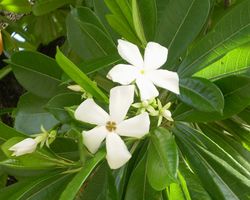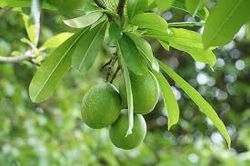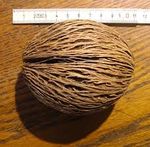Suicide tree
| Suicide tree |
|---|

|
| Scientific Classification |
|
| Scientific Name |
|
Cerbera odollam |
| Picture of the fruits of the Suicide Tree |
The Suicide tree is a highly toxic plant that is known by the scientific name Cerebra odollam. It is very common in India and perhaps best known for its use as a lethal agent. Despite its toxicity, it is a decorative plant with beautiful, white flowers.
Body Design
The Suicide Tree (Cerebra odollam) is a tree that likes to thrive in very moist, swampy areas. This plant can grow up to 30 feet tall, and has fruits that look like young, green, mangoes (Mango). The flowers of the tree are white, and have five lobes. The leaves of the tree are long and thick. [2] When the fruits fall to the ground, they lose their skin and expose a more thick, fibrous husk. This allows the seeds to be drawn into the ocean, where the currents can take them to their next destination. Most of these next places don't have to be very far. Wherever the water will carry the seeds, that is the spot that they will grow. This design is so that they can grow very close to a water source, where the soil is very moist. [3]
Life Cycle
The Suicide tree is a tree with fruits. When the tree drops its fruit, they are dispersed from water, or just sprout near the tree. The seeds of the tree usually start sprouting around July when it's warmer. Since the plant is a tropical plant, they could die in the winter, so they must be indoors, or at a warm temperature (above 3°C). [4]
Ecology
The Cerebra odollam is native to India and is very common to almost all parts of Asia. [5] These trees like to like in swampy areas, near rivers or streams. Most of the Cerebra odollam species usually are around the lower altitudes in primary rainforests, but some of the trees can sometimes thrive at 2000m. [6]
Toxicity
The seeds of the tree are used as homicide (killing of another person) or suicide in India. This is not the only place that this toxic is used. Other places like Madagascar have a long history with using this toxin. The poison was responsible for at least 2% of the population deaths of Madagascar.[2]
The toxic works by exciting the nerves and muscles, by transporting sodium out of the cell, while putting potassium into it. When it deactivates, it increases calcium, which increases in heart contractility, which could lead to arrhythmia. Another thing it does, is that it increases potassium. This is the same thing as lethal injections, where they also increase potassium chloride. In all of this, it also gives a feeling of nausea, and vomiting. [7]
Video
This video talks about the dangers of the plant and how people can use it for suicide.
References
- ↑ Classification for Kingdom Plantae Down to Genus Cerbera L USDA Plants Database. Web. Accessed May 29, 2017.
- ↑ 2.0 2.1 Cerberin: The Heartbreaker of the Suicide Tree Nature's Poisons. Web. Accessed May 14, 2017. Author Unknown
- ↑ National Tropical Botanical Garden Cerbera odollan. Web. Accessed May 23, 2017. Author Unknown
- ↑ Eva. A Surprising Tropical Plant Culture-Acre. Web. Created February 24, 2016.
- ↑ Growth Range Wikipedia. Web. Last edited January 19, 2015. Author Unknown
- ↑ Cerebra odollam Gaertner GlobinMed. Web. Last assessed May 23, 2017. Author Unknown
- ↑ Justin. Cerberin Nature's Poisons. Web. Posted March 18, 2015.



